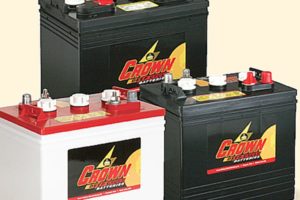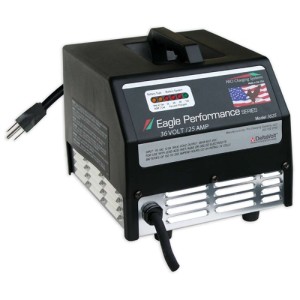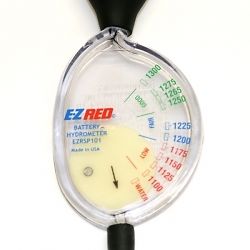Let’s face it. Floor Scrubber batteries can be expensive. The longer you can make them last, the more money you can keep in your pocket. With a little maintenance, a little knowledge, and inexpensive equipment, you can make them last!
Floor Scrubber Batteries
You need to start with the right battery. Make sure it is a true Deep Cycle battery. The Crown line of Deep Cycle batteries is a great choice. With their thick, advanced design plates, you get the cycles you need. Make sure you choose the correct size for your application. There are usually several choices that come in the same size battery case. The higher the Amp Hour Capacity, the longer the battery will last between charges. Also, the higher the Amp Hour, the higher the cost. When talking about Deep Cycle batteries, we speak in terms of Amp Hour and cycles. One cycle is a charge, a cooling period and a discharge. In terms of cycles, Crown Deep Cycle batteries are among the best!
the battery will last between charges. Also, the higher the Amp Hour, the higher the cost. When talking about Deep Cycle batteries, we speak in terms of Amp Hour and cycles. One cycle is a charge, a cooling period and a discharge. In terms of cycles, Crown Deep Cycle batteries are among the best!
Charging
Your goal is to fully charge your Floor Scrubber batteries after each use. Preferably, get them fully charged and in float at least 4 hours before use. This is the cooling period in the cycle. It is important to let the batteries cool before they are discharged again. The best way to determine your batteries are fully charged is with a hydrometer. 1.265 or higher specific gravity is fully charged. If your batteries are not fully charged after one charge cycle, put them back on for another cycle. There are a couple of reasons why your batteries might not be charged after one cycle:
- Your batteries are deeply discharged – below 80% DoD.
- Your charger is too small for your Floor Scrubber. Unfortunately, I see this more often than I would like. We suggest at least 15 Amps per 100 AH of battery capacity. For example: If your batteries are 195 AH, your charger output should be at least: (195 AH/100 AH) X 15 Amps = 29.25 Amps (30 Amps).
Another concern is what type of charger you are using. Most chargers these days are Solid State chargers. Some of these don’t fully charge your batteries after one cycle. We suggest the Dual Pro Charger from Pro Charging Systems. It is one of the best.
For larger jobs, where you have trouble making your bank last, use opportunity charging. During breaks, feel free to plug the unit in. This will help finishing the job, and keep your DoD to a more acceptable level. Higher DoDs affect the number of cycles in a negative way.
Floor Scrubber Battery Testing
As we stated earlier, make sure your bank is fully charged after each use. It is important to never let your batteries remain in a discharged condition. This causes sulfation and will lead to premature failure.
 Using a hydrometer is the best way to test a flooded battery For AGM and Gell, a digital voltmeter is a good way. But, make sure you test after the battery has rested for at least a couple of hours. This means off load and off charge for a few hours. Never assume that your bank is fully charged because the charger says it is. We suggest testing at least once a week for batteries that are discharged to 50% DoD. More often for lower DoDs.
Using a hydrometer is the best way to test a flooded battery For AGM and Gell, a digital voltmeter is a good way. But, make sure you test after the battery has rested for at least a couple of hours. This means off load and off charge for a few hours. Never assume that your bank is fully charged because the charger says it is. We suggest testing at least once a week for batteries that are discharged to 50% DoD. More often for lower DoDs.
Floor Scrubber Battery Maintenance
After you have selected the right batteries for your scrubber, it’s time to keep it running. You do this by maintaining your batteries to keep them in good condition:
- Watering

- State of Charge
- Connections
Watering
Keeping your batteries at the proper fluid level is important. Never allow the fluid level to drop below the top of the plate. If the plate becomes exposed, it will dry out and corrosion will begin to form. This portion of the plate will become unusable. When to water and how much to add:
- Inspect and add after charging.
- Add before charging only if the battery fluid is below the top of the plate.
- Batteries should be checked weekly for proper fluid levels.
- Fluid levels should be 1/4” below the vent well.
- Never fill up into the vent well.
- Over-filling will cause tray corrosion, shorts, acid loss, reduced capacity and premature failure.
- Distilled water is the best. Never use well or spring water.
Batteries use more water under the following conditions:
- Aged or older batteries
- Higher temperature environments
- Over charging your bank
State of Charge
I continue bringing this up, but that’s how important it is. Make sure your batteries are at a full charge when your charger goes into float! If not, put them back on charge for another cycle. When using the hydrometer, the individual cell readings should be within 50 points, after a full charge. If not, it indicates a weak cell and could cause performance issues. Take note of the clarity of the electrlyte. It should be clear. If it is cloudy or dark, it indicates plate breakdown. This can be caused by aging batteries, low fluid levels, overcharging or excess heat.
Connections
Keep your terminals free of corrosion. Corrosion causes poor connections which degrade performance. It can also be the cause of under-charging. Use a wire brush and a baking soda based cleaner. Apply a corrosion preventative once terminals are clean. Keep the batteries clean and dry as best you can. Keep water from collecting on the tray.
Follow these guidelines to get the most out of your scrubber investment. You can get several years out of your scrubber batteries if you take care of them.
As always, American Battery Corporation is here to answer your questions or concerns. Give us a call or stop by – we love to solve problems. Remember, “We Sell Batteries – Knowledge and Service are Free”.